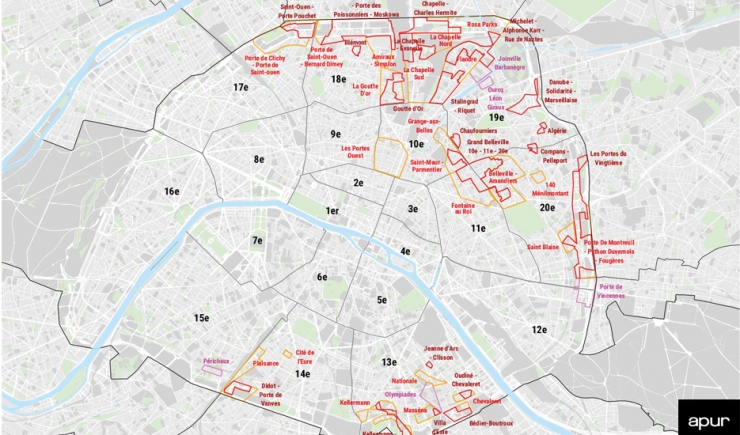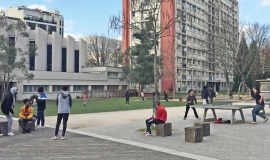
Following on from the 2007-2014 Urban Contract for Social Cohesion, the Planning Act for the City and Urban Cohesion of 21st February 2014 redefines, at a national level, the boundaries of Neighbourhoods of the City Urban Cohesion Policy, repositioning them around the areas most in difficulty. The 2015-2023 geographical priority areas include two levels of intervention, the priority neighbourhoods determined on the basis of the single criteria of the concentration of poverty and neighbourhoods of the previous Urban Contract for Social Cohesion which remain under observation as neighbourhoods to be actively monitored.
In Paris, the geography of the City’s urban policy 2015-2023 covers a total of 360,000 inhabitants, i.e. 17% of the Parisian population, on a territory of 1,276 hectares, i.e. 12% of the surface area of Paris.
The twenty priority neighbourhoods are spread among eight districts - arrondissements -, with a total of 165,900 inhabitants on a territory of 705 hectares. The neighbourhoods being actively monitored are located in the same eight districts, accommodating 194,300 inhabitants, on a territory of 571 hectares.
Priority neighbourhoods concentrate a higher proportion of vulnerable inhabitants and households than the Parisian average (young people, single parents, low income households, people with no qualifications, job seekers, etc.). Certain social gaps have narrowed between the population of these neighbourhoods and the rest of Paris during the recent period (social indicators, school achievement, economic dynamism, living conditions) with at the same time the insecurity indicators remaining high and the gaps in employment and professional integration being maintained.
Neighbourhoods of the City’s Urban Cohesion Policy (GPV) benefit from action aimed at improving the quality of life of inhabitants and in reducing socio-economic inequalities. The City Contract is the governance tool for coordinating the direction and commitments of institutional, economic and associative partners in each area. In Paris, this is organised around three main themes (Growing up - Working - Living) and includes the cross-cutting themes (social links, access to rights, gender equality, health and the fight against discrimination). Action takes many different forms : reducing gaps in achievement levels at school, promoting access to employment, encouraging the social and professional integration of young people, acting on local economic development, preventing situations of precariousness, promoting mobility and diversity, supporting urban transformation and integrating neighbourhoods into the city better, etc. Apur has accompanied these actions for several years by implementing the Observatory of Parisian Neighbourhoods of the City’s Urban Policy and by carrying out studies which contribute to the evaluation of the 2015-2023 Paris City Contract.

